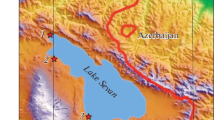Abstract
The paper presents data on the geographic and geological conditions of modern sedimentation in Lake Untersee, the largest lake in East Antarctica. Geochemical and sedimentation data indicate that the leading mechanism providing Al-Si sedimentary material to the surface layer of the bottom sediments is the seasonal melting of the Anuchin glacier and the mountain glacier on the southeastern face of the valley hosting the lake. The strongly reduced conditions in the lowermost 25 m of the water column in the smaller of the two depressions at the lake bottom were favorable for the enrichment of the bottom sediments in bacteriogenic organic matter, Mo, Au, and Pd. The H2S-contaminated water facilitates the significant enrichment of the sediments only in redox-sensitive elements able to migrate in the form of anionic complexes and precipitate (coprecipitate) as sulfides.
Similar content being viewed by others
References
A. Loopman, E. Kaup, V. Klokov, I. Simonov, and D. Haendel, “The Bathymetry of Some Lakes of the Antarctic Oases Schirmacher and Untersee,” in Limnological Studies in Queen Maud Land (East Antarctic), Ed. by J. Martin (Valgus, Tallinn, 1988), pp. 6–14.
U. Wand, V. A. Samarkin, H.-M. Nitzsche, and H.-W. Hubberten, “Biogeochemistry of Methane in the Permanently Ice-Covered Lake Untersee, Central Dronning Maud Land, East Antarctica,” Limnol. Oceanogr. 51(2), 1180–1194 (2006).
The Schirmacher Oasis, Queen Maud Land, East Antarctica, and Its Surroundings, Ed. by P. Bormann and D. Fritzsche (Justus Perthes Verlag, Gotha, 1995).
M. J. Schwab, “Rekonstruktion der Spatquartaren Klima- und Umweltgeschichte der Schirmacher Oase und des Wohltnat Massivs (Ostantarktika),” Ber. Polarforschung, No. 293, (1998).
Ch. McCay, Oral Communication, 2009.
U. Wand and J. Perlt, “Glacial Boulders “Floating” on the Ice Cover of Lake Untersee, East Antarctica,” Antarct. Sci. 11, 256–260 (1999).
M. G. Ravich and D. S. Solov’ev, Geology and Petrology of the Central Part of the Queen Maud Land (East Antarctica) (Nedra, Leningrad, 1966) [in Russian].
A. Hiller, U. Wand, H. Kämpf, and W. Stackebrandt, “Occupation of the Antarctic Continent by Petrels during the Past 35000 Years: Inferences from a 14C Study of Stomach Oil Deposits,” Polar Biol. 9, 69–77 (1988).
E. Kaup, A. Loopman, V. Klokov, I. Simonov, and D. Haendel, “Limnological Investigations in the Untersee Oasis (Queen Maud Land, East Antarctica), in Limnological Studies in Queen Maud Land (East Antarctica),” (Valgus, Tallinn, 1988), pp. 28–42.
U. Wand, G. Schwarz, E. Brüggemann, and K. Bäner, “Evidence for Physical and Chemical Stratification in Lake Untersee (Central Dronning Maud Land, East Antarctica),” Antarct. Sci. 9, 43–45 (1997).
J. C. Priscu and C. M. Foreman, “Lakes of Antarctica,” in Encyclopedia of Inland Waters, Ed. by G. E. Likens (Elsevier, Oxford, 2009), vol. 2, pp. 555–566.
I. Hawes. Oral Communication, 2009.
O. A. Tyutyunnik, D. N. Chkhetija, M. L. Getsina, et al., “Microelement Composition of Boundary Cenomanian-Turonian Sediments of Crimea Mountains and North-Western Caucasus,” Eur. J. Analyt. Chem. 3, 91–112 (2008).
M. A. Levitan, I. A. Roshchina, and A. V. Tolmacheva, “Geochemical Features of Sediments on the Continental Slope of the Weddell Sea and Their Paleoceanographic Interpretation,” Litol. Polezn. Iskop., No. 2, 128–142 (2008) [Lithol. Miner. Res. 43, 111–124 (2008)].
P. E. Biscaye, “Mineralogy and Sedimentation of Recent Deep-Sea Clay in the Atlantic Ocean and Adjacent Seas and Oceans,” Geol. Soc. Am. Bull. 76, 803–832 (1965).
N. Hultzsch, “Lakustrine Sedimente als Archive des Spätquartären Umweltwandels in der Amery-Oase, Ostantarktis,” Ber. Polarforschung, No. 545, 185 (2007).
R. Hoover, Personal Communication, 2009.
M. A. Levitan, D. Nürnberg, R. Stein, et al., “Role of Cryosols in the Accumulation of Modern Bottom Sediments in the Arctic Ocean,” Dokl. Akad. Nauk 344(4), 506–509 (1995).
V. G. Shlykov, X-Ray Analysis of Mineral Composition of Dispersed Grounds (GEOS, Moscow, 2006) [in Russian].
V. A. Drits and A. G. Kossovskaya, Clay Minerals: Micas and Chlorites, Tr. Geol. Inst. Akad. Nauk SSSR, (Nauka, Moscow, 1991), vol. 465 [in Russian].
Anorthosite: Average Chemical Composition (Gosstandart, Moscow, 1987) [in Russian].
Ya. E. Yudovich and M. P. Ketris, Principles of Lithochemistry (Nauka, St. Petersburg, 2000) [in Russian].
Yu. A. Balashov, Geochemistry of Rare Earth Elements (Nauka, Moscow, 1976) [in Russian].
F. P. Lesnov, Rare-Earth Elements in the Ultramafic and Mafic Rocks and their Minerals. Book 1. Main Rock Types. Rock-Forming Minerals (“Geo”, Novosibirsk, 2007) [in Russian].
G. M. Varshal, T. K. Velyukhanova, I. Ya. Koshcheeva, et al., “Studying of Chemical Speciation of Elements in Surface Waters,” Zh. Anal. Khim. 38(9), 1590–1600 (1983).
A. Usher, D. C. McPhail, and J. Brugger, “A Spectrophotometric Study of Aqueous Au(III) Halide-Hydroxide Complexes at 25–80°C,” Geochim. Cosmochim. Acta 73, 3359–3380 (2009).
I. V. Kubrakova, G. M. Varshal, Yu. F. Pogrebnyak, and T. F. Kudinova, “Pt and Pd Migration Species in Natural Waters,” in Chemical Analysis of Marine Sediments (Nauka, Moscow, 1988), pp. 104–119 [in Russian].
V. G. Moiseenko, “Problems of Gold Nanogeochemistry,” in Gold Nanogeochemistry (Dal’nauka, Vladivostok, 2008), pp. 6–30 [in Russian].
B. R. Ginn and J. B. Fein, “The Effect of Species Diversity on Metal Adsorption Onto Bacteria,” Geochim. Cosmochim. Acta 72, 3939–3948 (2008).
Ya. E. Yudovich and M. P. Ketris, Trace Elements in Black Shales (UIF Nauka, Yekaterinburg, 1994) [in Russian].
S. R. Taylor and S. M. McLennan, The Continental Crust: Its Composition and Evolution (Blackwell, Oxford, 1985; Mir, Moscow, 1988).
F. P. Shepard, “Nomenclature Based on Sand-Silt-Clay Ratios,” J. Sediment. Petrol 34, 151–158 (1954).
Author information
Authors and Affiliations
Corresponding author
Additional information
Original Russian Text © M.A. Levitan, Yu.P. Girin, V.L. Luksha, I.V. Kubrakova, I.A. Roshchina, B. Sattler, O.A. Tyutyunnik, M.Yu. Chudetskii, 2011, published in Geokhimiya, 2011, Vol. 49, No. 5, pp. 483–505.
Rights and permissions
About this article
Cite this article
Levitan, M.A., Girin, Y.P., Luksha, V.L. et al. Modern sedimentation system of Lake Untersee, East Antarctica. Geochem. Int. 49, 459–481 (2011). https://doi.org/10.1134/S0016702911050077
Received:
Published:
Issue Date:
DOI: https://doi.org/10.1134/S0016702911050077




